Trezor Model T Review 2024: The Ultimate Crypto Storage Wallet

Trezor is a leading brand in the hardware wallet industry and one of the most trusted devices for crypto storage. Trezor is one of the best-selling wallets, beloved by hundreds of thousands of users and crypto security experts.
2022-2023 have been abominably dismal years for crypto traders. We saw four or five “once in a lifetime” events and market turmoil following the pandemic lockdowns, the historic Terra Luna collapse, insolvency from Celsius, 3AC, BlockFi, Voyager, and VAULD, the horrendous FTX collapse, then the longest crypto bear market in history, all of which resulted in crypto users losing billions in crypto assets. If 2022/2023 could be summed up in three letters, it would be “WTF?”
Well, hold on my crypto friends because as they say, it is always darkest before the dawn, and if we are to take one lesson and one silver lining from the past year, it would be that self-custody and DeFi remain intact with stronger use cases than ever. Decentralization and self-custody is sort of the whole point of crypto, isn’t it?
Crypto did not fail us the past couple of years, ladies and gentlemen, people did. It was the people behind these companies driven by greed that has given crypto its blackest eye to date. It’s time we stop blindly trusting custodial platforms and intermediaries poisoned by corruption and take control of our own finances and start practicing self-sovereignty with hardware wallets, which is why we felt the need to bring this Trezor Model T review to you today.
Why Use a Hardware Wallet?
While everything is burning to the ground in crypto-land with fraud, insolvency, scams, and hacks running rife, you know who’s kicking back, completely relaxed and not losing a wink of sleep? Those who self-custody their crypto in a hardware wallet.
Another trend we have seen in 2023 is a record outflow of crypto from exchanges as users have lost all trust in centralized platforms and are choosing to self-custody their crypto…Smart Move 😎
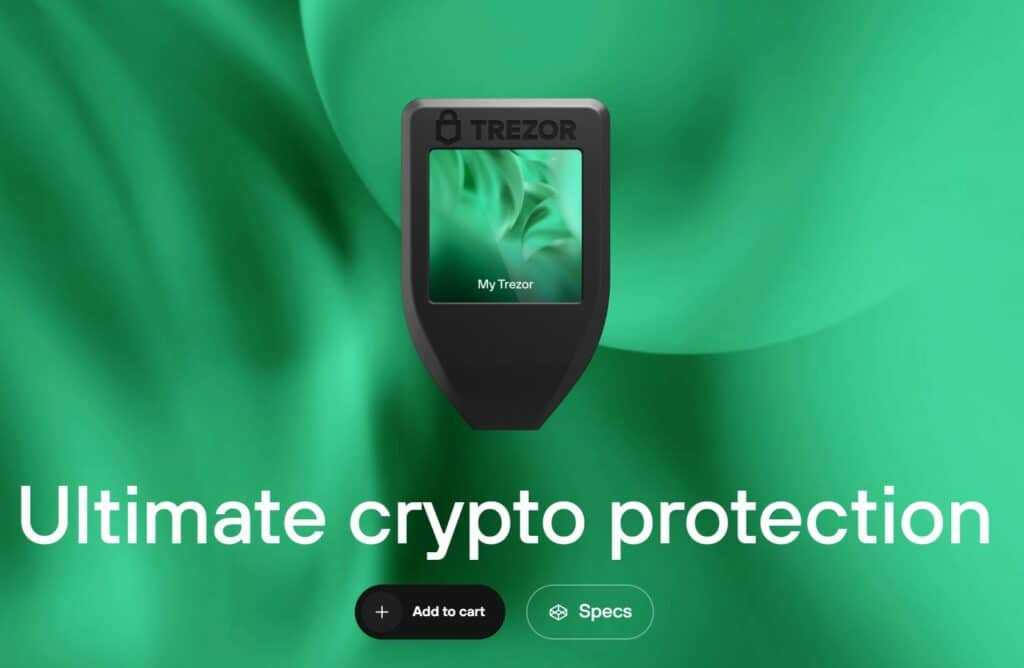
If this is your first time learning about crypto storage, there are some basics to cover. Hardware wallets are devices that hold your private keys securely in an offline environment and are widely considered the most secure solution for crypto storage.
Hardware wallets come in all shapes and sizes with some appearing to be little more than USB sticks, to others that look more like a mobile phone. Here is a photo of three popular hardware wallets, a Trezor, Ledger, and ELLIPAL, to compare the differences in size and appearance.
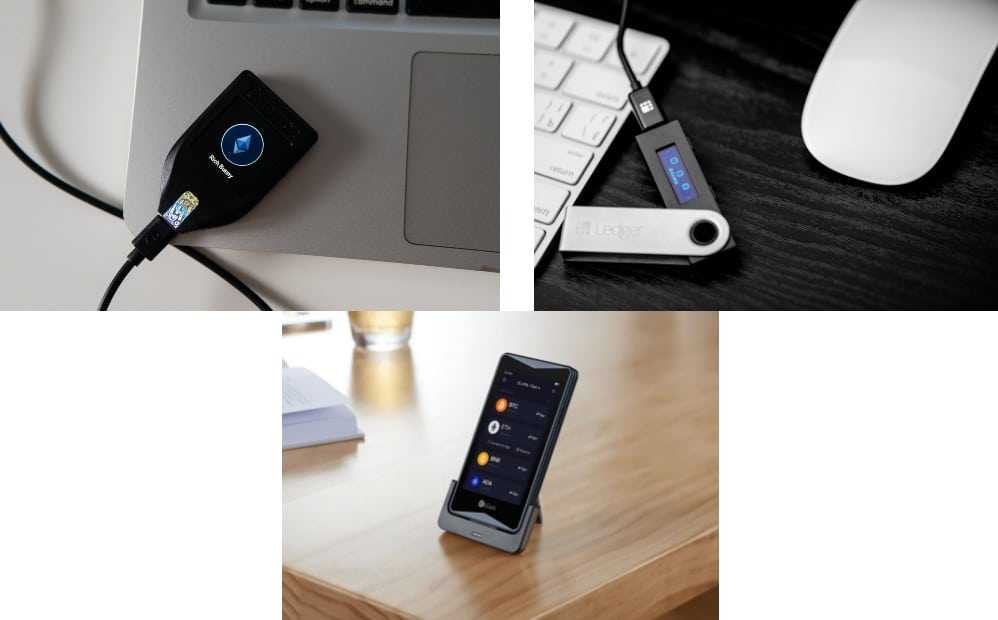
There are 4 main ways in which crypto users store their digital assets:
On an Exchange – This is the least safe method, but quite common as it is highly convenient. Many crypto users never take their crypto off of an exchange, but this is a really bad idea unless you are actively trading funds. Crypto exchanges are popular targets for hackers, and you do not actually own your crypto when it’s held on an exchange or centralized platform.
Exchange hacks are quite common, and as we have seen happen when companies like FTX, BlockFi, and Celsius go under, they lock all user funds and disable withdrawals. There is a high likelihood that FTX and Celsius users may never have their funds returned to them, which is why keeping crypto on an exchange or centralized platform isn’t the best idea.
Software Wallets/Hot Wallets – These are wallets that can be downloaded onto a phone or desktop computer. While these are considerably better than keeping funds on an exchange, as at least users are in control over their own crypto, the fact that these wallets are installed on devices with access to the internet leaves funds vulnerable to hackers. These are referred to as “hot” wallets, hot referring to internet connectivity.
Internet connectivity is the number one security vulnerability for crypto storage as this provides hackers with an exploitable method for accessing a user’s device and extracting the private keys that provide them with access to a user’s crypto assets. There are also viruses and malware that can be installed that can expose private keys or take over a user’s clipboard when they go to copy/paste wallet addresses.
Viruses, malware, and hacks are the key reasons why software/hot wallets are less secure than hardware wallets. Mobile software wallets are quite popular as they are highly convenient for crypto use on the go and most of them are completely free. You can learn more in our article on the Top Mobile Wallets.
Hardware/Cold Storage Wallets – This is the most popular method for crypto users who are serious about safe crypto storage. These devices hold the private keys needed to access crypto but are never connected to the internet, which is why the term “cold” is used. Hardware wallets are impervious to remote hacks, viruses, or malware, as there is no online, NPC, or Bluetooth connectivity, there is no “back door” that can be exploited by hackers, and no way a virus can be installed on the device.
Here is a great image from Crypto.com summarizing hardware vs software wallets:
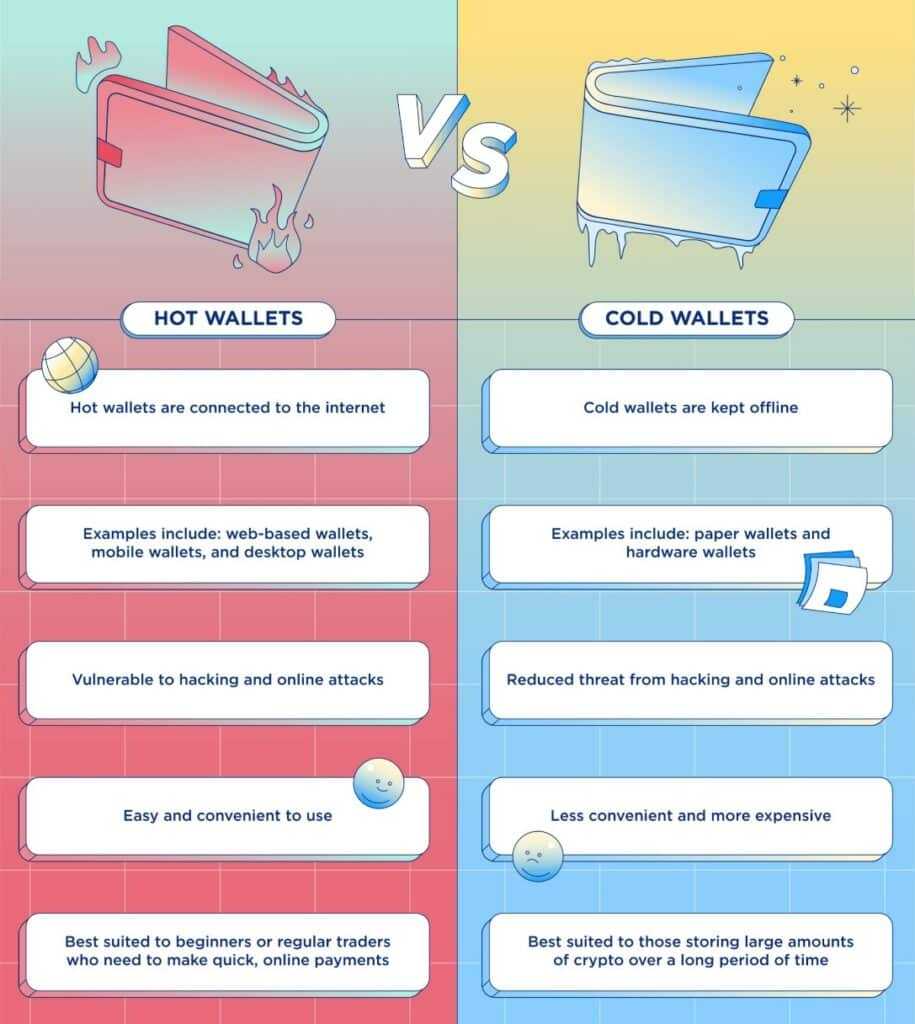
Hardware wallets can even be safely connected to a computer infected with viruses and malware and used without risk as the infection cannot spread to the hardware wallet.
Paper Wallet – The final way that some users manage crypto is by using what is known as a paper wallet. Paper wallets are arguably the most secure as it is definitely impossible to hack a piece of paper.
Paper wallets are quite inconvenient though as paper also cannot send crypto transactions, and this method has become less popular as paper is fragile and vulnerable to loss.
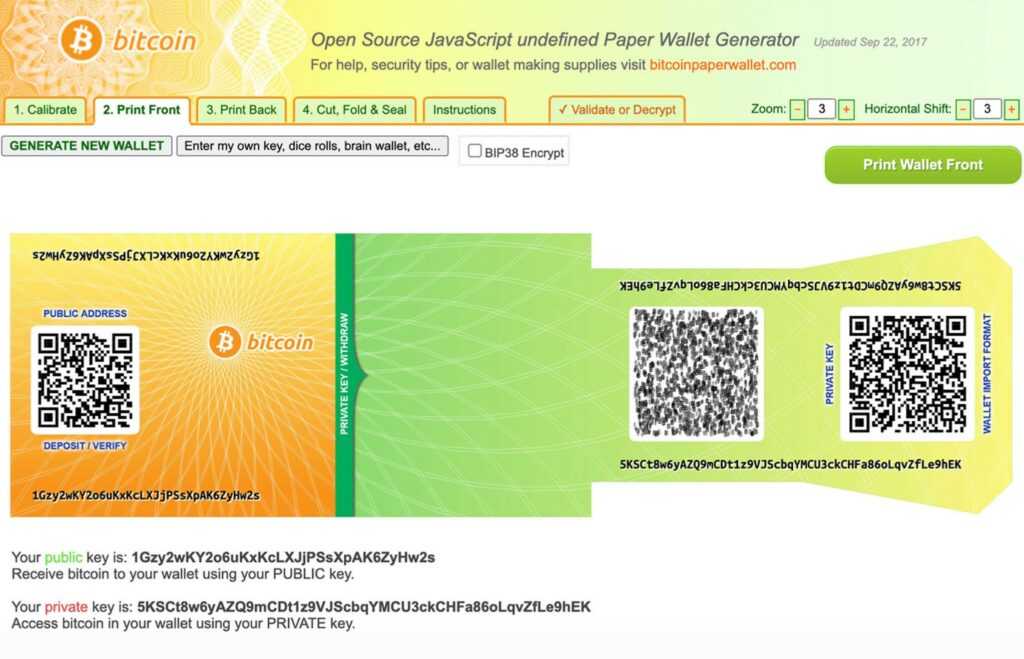
Hardware wallets provide a good balance between security and convenience, with users who trust the devices being able to rest easy knowing their funds are safe.
Hardware wallets not only store your private keys in the most secure manner but also sign transactions on a user’s behalf when verified by the holder, adding another layer of protection against unauthorized transactions.
Popular hardware wallets include Trezor, Ledger, ELLIPAL, and NGRAVE. Feel free to explore other hardware wallets in our article on the Top 5 hardware wallets, or alternatively, you can find Guy’s picks on the best hardware wallets below and hear why Trezor is one of his top choices:
Who is the Team Behind Trezor?
Trezor is a product created by Satoshi Labs, a company based in Prague in the Czech Republic. Satoshi Labs was founded in 2013, though its founders, Pavol Rusnak, Marek Palatinus, and Alena Vránová, had been working on secure solutions for safely storing private keys for some time before that.

Development work continued until 2014, when the Trezor One was launched, the first cryptocurrency hardware wallet to hit the market. Its release is considered a milestone in the journey of crypto development and sparked a revolution in crypto security, offering users a way to fight back against hackers and furthering the entire industry.
Trezor has become hugely popular in the crypto community, sold to hundreds of thousands of customers in over 150 countries to become one of the best-selling wallets in the world due to its proven track record of security and ease of use. The Trezor Model T is also a favourite for crypto users who prefer a touch screen and are interested in good asset support.
The ability to purchase crypto with fiat and exchange within the wallet only bolsters its popularity, making the device multi-functional and able to meet the needs of most crypto users.
The Trezor team has also earned a nod from the tech community for fully open-sourcing all the code for the Trezor devices, firmware, and Trezor Suite, meaning that anyone can go in and verify the source code for themselves to ensure there is no malicious or error-ridden code in the software.
Trezor Model T Review: Features
Following the success of the Trezor One, the Trezor team upped the ante and unveiled the Model T in February 2018. It was an instant hit and a clear upgrade over the Model One as the Model T features a coloured touchscreen and better asset support.
Upon purchasing a Trezor, users will find the following items in the box:
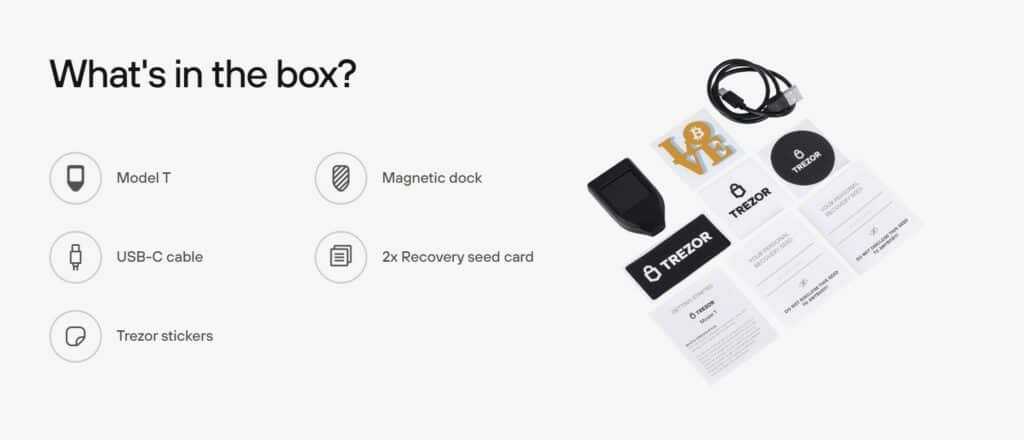
- Trezor Model T
- Model T magnetic dock
- USB-C cable
- 2x Recovery seed card
- Trezor stickers
The 240×240 pixel display screen makes navigating the device easier and more convenient than the non-touchscreen Trezor One, though the screen is quite small, requiring some accuracy when trying to type in the passcode.
The Model T is built with an ARM Cortex-M4 processor, a USB-C port, and a microSD card slot. At just 22 grams, it’s light as a feather and super small, making it very convenient to store, hide, and carry.
Trezor Specs:
- Size: 64x39x10 mm (2.52x1.54x0.39 in)
- Weight: 22 g (0.77 oz)
- CPU: 168 MHz embedded ARM processor (Cortex-M4) running Trezor Core
- Connectivity: USB-C cable to connect to computer and mobile
- Touchscreen: 1.54'' Color LCD 240x240 pixels
Supports over 1,800 cryptocurrencies
The Trezor Model T boasts support for an impressive 1,816 coins and tokens, and all 10,000 + ERC20 tokens either natively within Trezor Suite, or through one of the third-party integrated wallets.
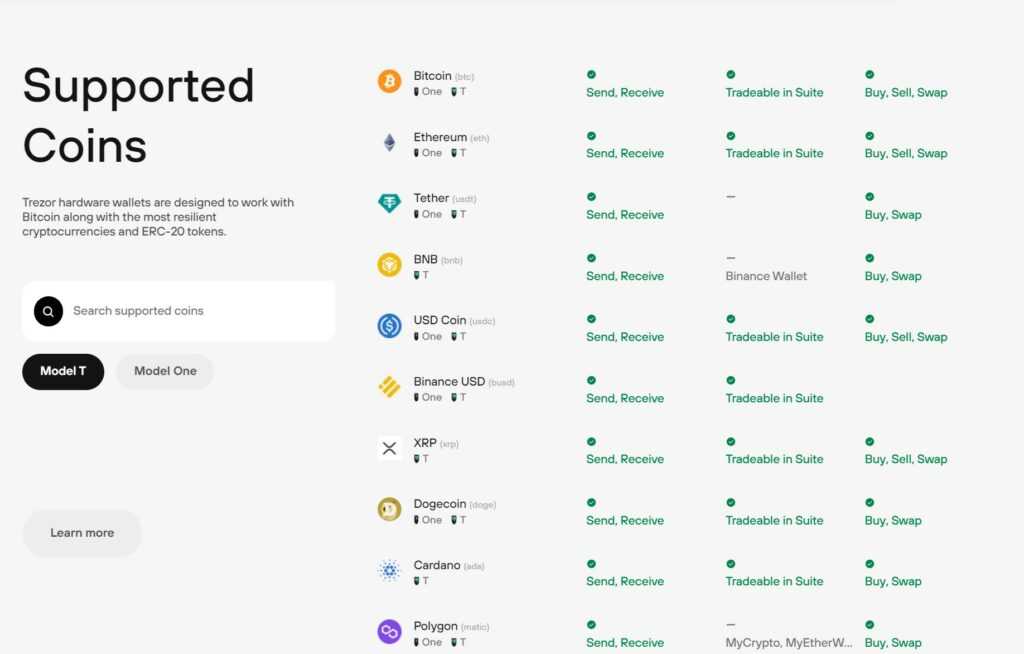
Take a look at the Trezor Model T Supported Coins page for a full list.
Fans of Cardano will be thrilled to find out that they can safely stake ADA directly from their Trezor, providing the most secure way to stake funds.
NFT Storage
Holders of non-fungible tokens can store them safely with the Trezor Model T as long as they are held on a network that's compatible with Trezor’s firmware. The only downside is that for now, the Trezor Suite app can’t manage NFTs, so NFT transactions will need to be completed by connecting your wallet to a third-party app like Metamask.
Digital Identity and Password Management
The Trezor Model T is quite versatile and can be used for more than just crypto. The device can also be used as a password manager and as a secondary layer of security in two-factor authentication (2FA) and multi-factor authentication.
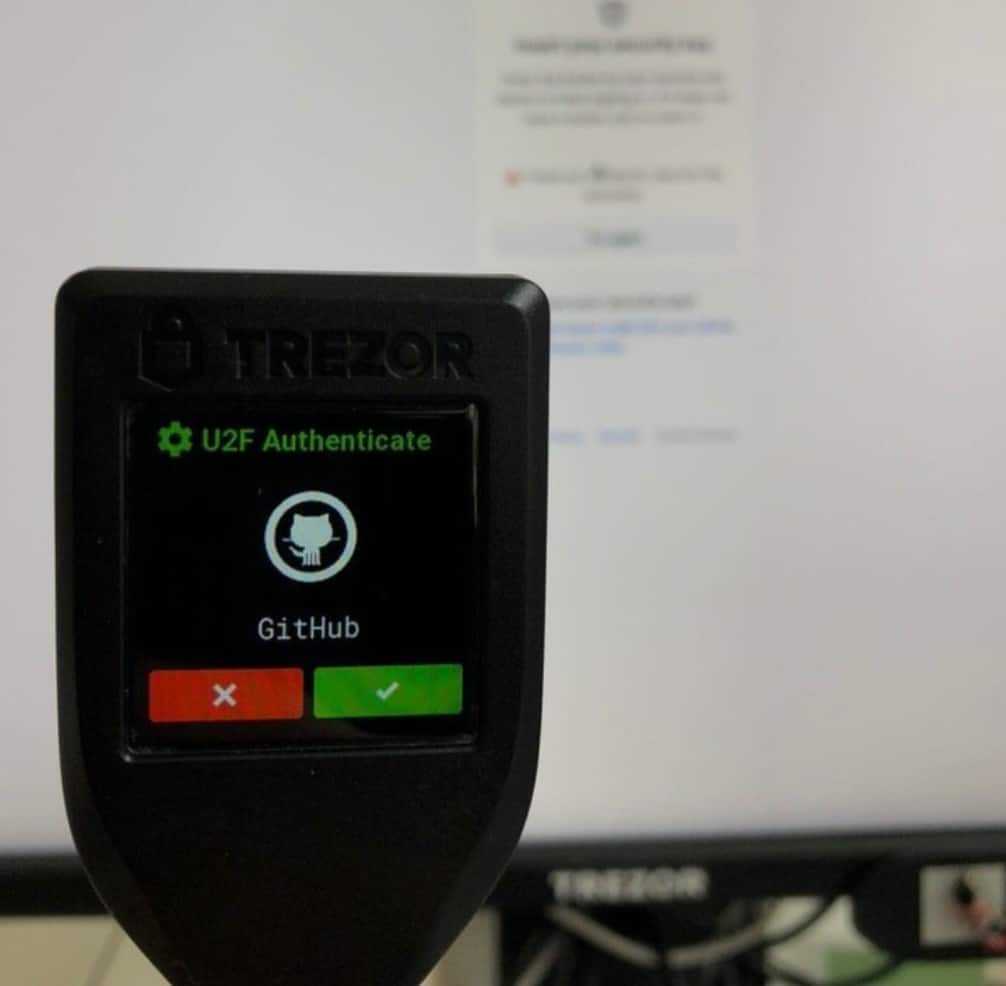
Using a Trezor device for 2FA has an advantage over the traditional method as users do not need to trust a third-party authentication service like Google. The way it works is that when you connect your Trezor and log in to a website, instead of typing in a code from your phone, you can authorize login directly from the Trezor device.
You can learn more about this feature in Trezor’s blog on 2FA.
MicroSD Card Security Option
Featured on the Trezor Model T is a slot that can fit a MicroSD card. Users can enable a feature in which the wallet can only be unlocked if a recognized card is inserted, adding an additional layer of security. This feature can be enabled or disabled when a card is inserted.
Trezor Suite
Trezor devices connect to a computer using a USB cable, enabling users to send, receive, buy, and sell cryptocurrency using the synchronized Trezor Suite app when the device is connected.
Trezor Suite is the native Trezor interface that allows users to access and interact with their crypto. It is a fantastic, easy-to-use and navigate clean platform that makes holding and using crypto a breeze.
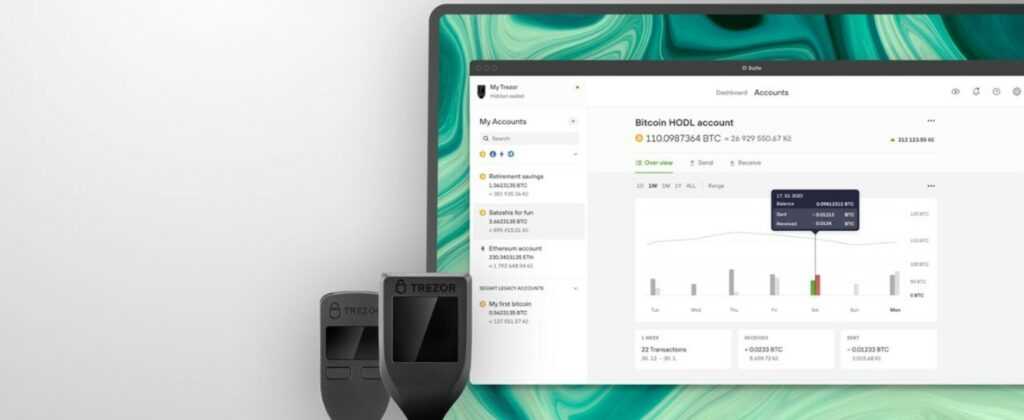
Trezor Suite is an app that is available for download on a desktop or accessed via web browser. When a Trezor is purchased and plugged in, the user will be prompted to download Trezor Suite directly on their Windows, Mac, or Linux machine, or alternatively, the program can also be found and downloaded via the Trezor Suite page.
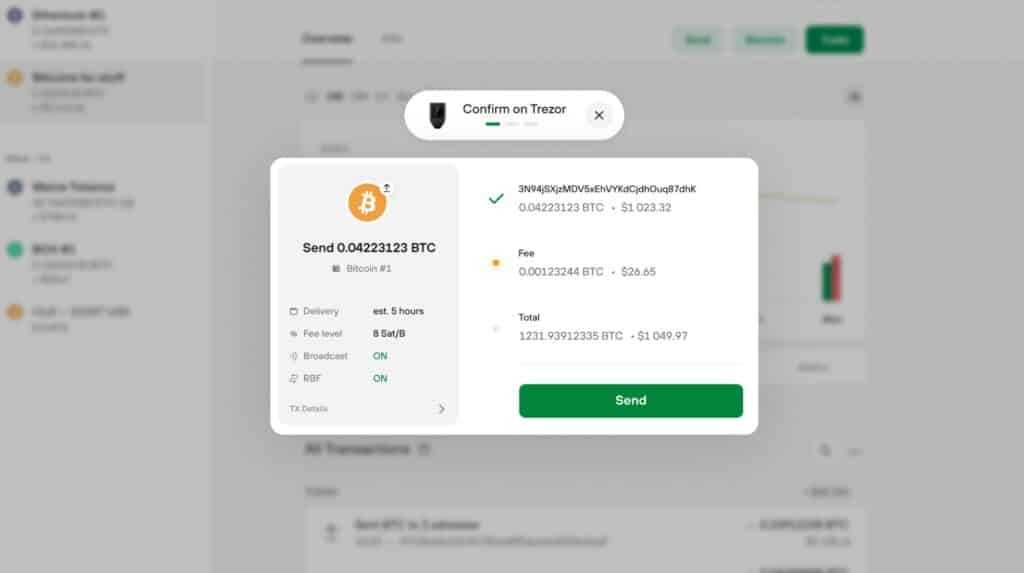
**Important Notice** Trezor does not have a mobile app and has no IOS support. Trezor is primarily used by being plugged into a computer or can be plugged into an Android phone with Trezor Suite being accessed via web browser. There have been fake Trezor apps floating around in the Google Play and Apple App store, resulting in hackers stealing funds.
The Trezor Suite app makes managing crypto incredibly easy and convenient. It provides one of the best interfaces I have used for crypto management.
With a built-in portfolio tracker showing your funds’ value and performance, tracking portfolio performance is easy and users can access their full transaction history and export files, making taxes as painless as possible.
The settings area also has a boatload of extra security features and functions, all of which can be accessed with an intuitive and brilliant UI/UX.
The Trezor Suite is highly secure and functional, providing options for users to buy and sell crypto peer-to-peer or via various third-party payment processors.
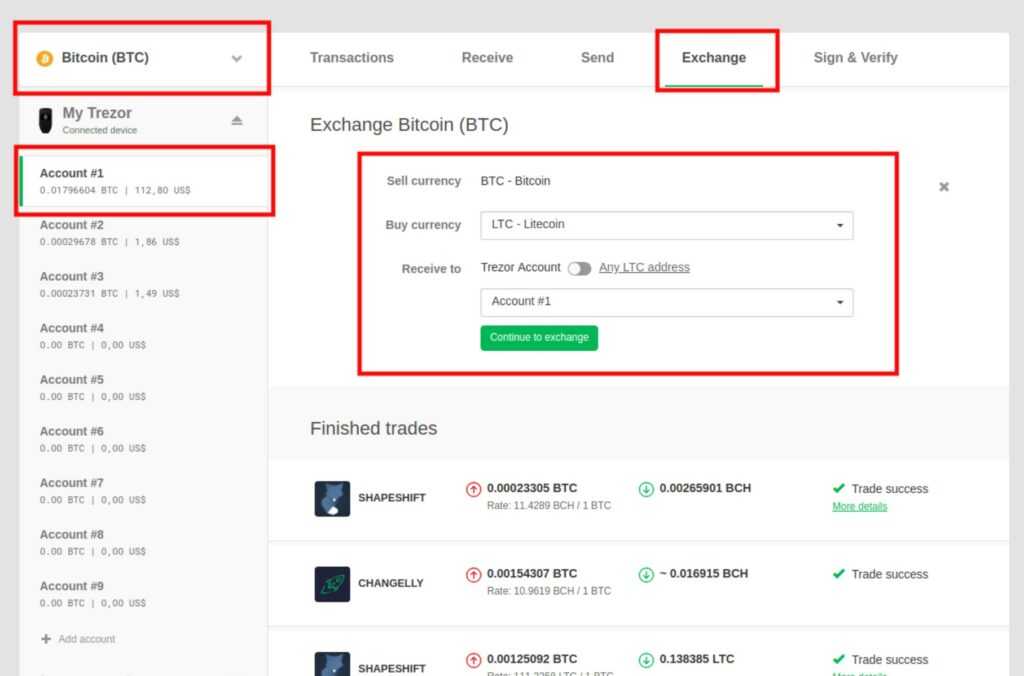
Trezor Model T Price
As the Model T is Trezor’s flagship product, it does come with a bit of a hefty price tag, which is the largest criticism against the wallet. The device comes in at 269 EUR (Approx.: 280 USD or 230 GBP), which is over three times more expensive than the Trezor One.
If you are looking to save a few bucks, check out our Trezor One vs Trezor Model T article to see if the Trezor Model T is worth the extra money for you. The major difference between the two is the touchscreen, a stronger processor, and better coin support. The Trezor One is still a highly secure and fantastic hardware wallet for those looking to save a few bucks, you can learn more about it in our Trezor One review.
If you are after a touchscreen hardware wallet for a steal of a price, you may also be interested in our ELLIPAL Titan Mini review. The Titan Mini is one of the best value-for-money hardware wallets featuring a touch screen.
Trezor products
Trezor offers more than just hardware wallets. While their two hardware wallets, the Trezor One and the Trezor Model T are what they are best known for, the Trezor store also offers a whole suite of products to instil confidence in crypto holders.
The most important step for users when setting up a software or hardware wallet for the first time will be writing down and securing the 12 or 24 recovery phrase. Most hardware wallets come with pieces of paper to write this seed phrase down. The reason I say that this is the most important step is that if you lose or break your wallet or phone with a wallet installed on it, the recovery phrase will be the only way to recover those funds.
You can learn more about this “most important step in crypto” in our article How to Keep your Crypto Safe.
Anyway, I don’t know about you, but something as important as a recovery phrase is worth storing on something less fragile than a piece of paper, which is why Trezor offers these metal seed phrase storage products:
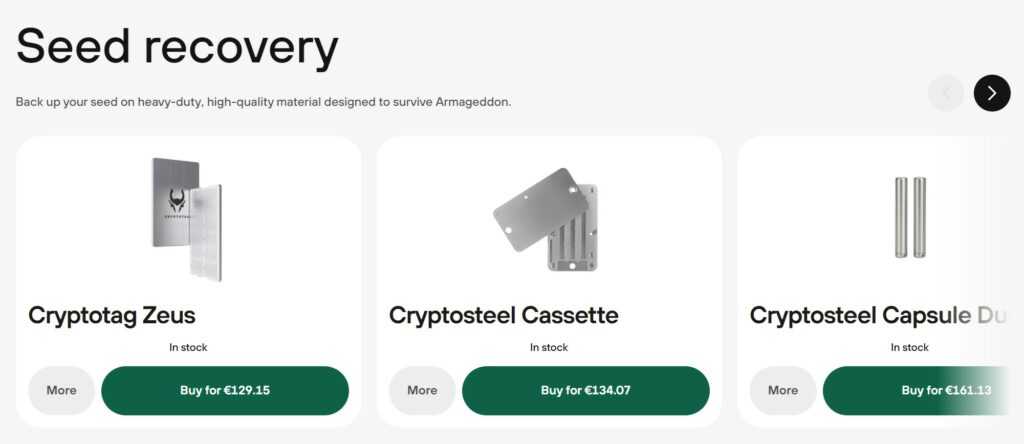
These are perfect as users can store their recovery/seed phrases on metal that is fire and waterproof to ensure they will always be able to recover their crypto.
We are such big supporters and advocates of metal seed phrase protection here at the Coin Bureau that we also offer a Coin Bureau branded metal seed wallet in the Coin Bureau Merch Store.
As the Trezor Model T is made out of thin plastic and isn’t the most durable hardware wallet out there, Trezor also sells covers, cases, screen protectors, and lanyards which are a good idea if you are going to be tossing the device in a bag and taking it on the go.
Trezor Model T Security
Hardware wallets are all about security and Trezor certainly does not disappoint. You don’t become one of the most trusted brands in the space without exceeding security expectations.
The device itself can be pin and passphrase protected. The pin protects from unauthorized access to the device while the passphrase can protect your crypto even in the event someone somehow manages to acquire your 12-word recovery phrase.

Trezor does not collect any personal data, the device packaging is tamper-proof, and the devices arrive without firmware pre-installed to ensure they were not tampered with during transit. All Trezor devices come with security seals that look like this:

If your device arrives without this seal, be sure not to use it and send it back to Trezor. And that brings us to the next important point, be sure to only purchase your Trezor devices directly from the Trezor website.
Never purchase any hardware wallet from unofficial sources and never secondhand. A common scam is that people will sell their hardware wallets but keep access to the recovery phrase. As soon as a new user loads their crypto onto the device, the previous owner swipes the funds.
The Model T is held together with ultrasonic welding, meaning there are no connective bolts, nails, soldering materials, or adhesives holding the case together.
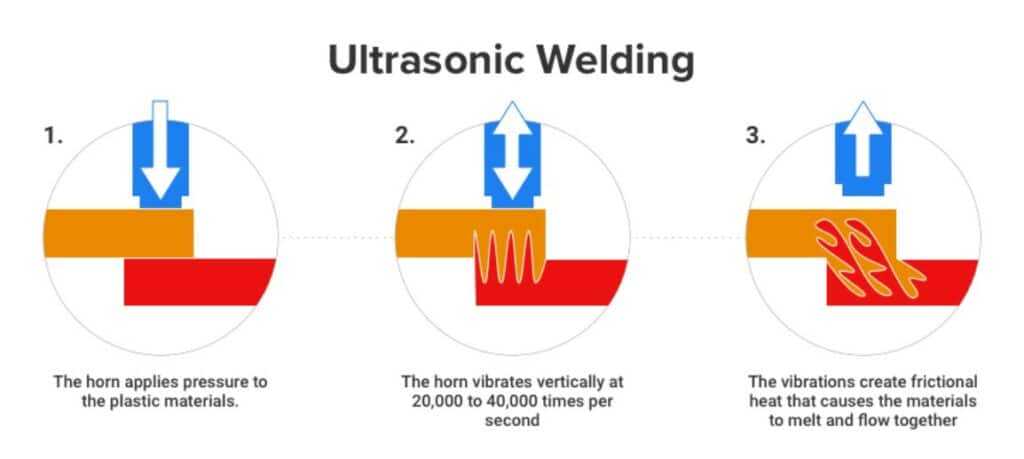
This helps to ensure that the device cannot be cracked open by hackers without damaging all the components and rendering the device unusable.
Trezor devices are also CE and RoHS security certified, so they meet all quality, reliability, and environmental safety standards. These are seriously secure little devices, you really can’t go wrong trusting your crypto with Trezor.
For the privacy-minded, Tezor's Coinjoin feature lets you protect your identity with transaction anonymization.
Trezor Support
Trezor has a well-populated FAQ and self-help section full of articles and video tutorials to help customers get familiar with the product. The Trezor blog is also full of helpful educational content that is great for understanding the crypto space.
The Trezor help center will be able to address the majority of issues, questions, and concerns, which is helpful as unfortunately, the Trezor team is not known for timely customer support.
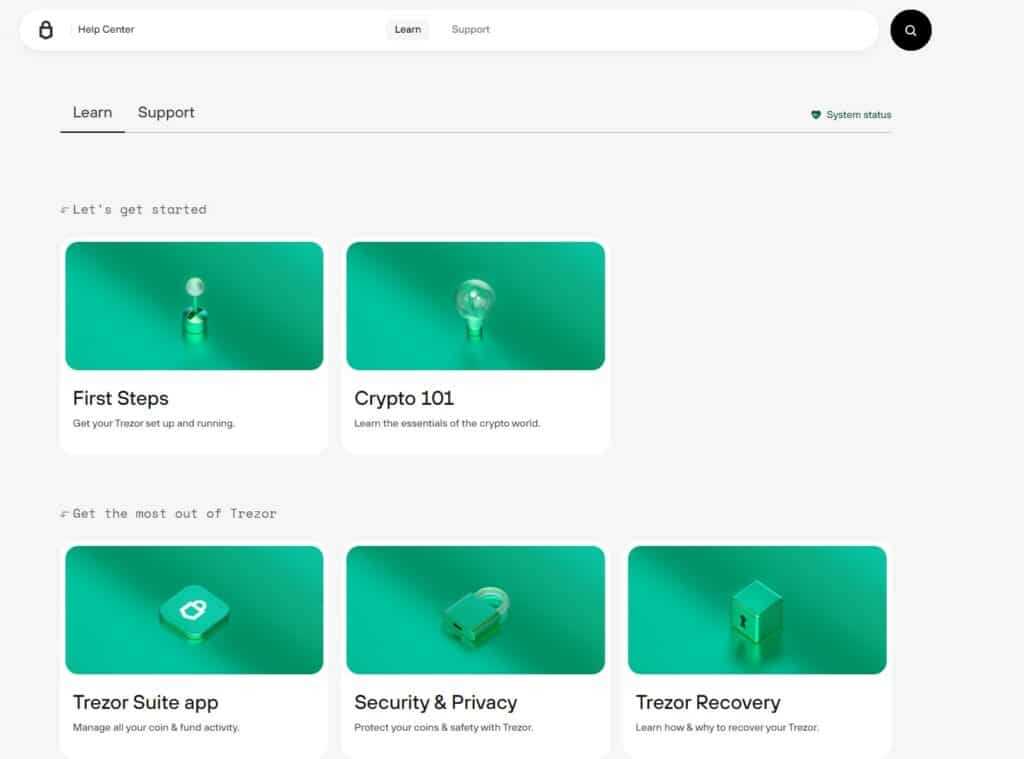
It is very important to stress that if you lose your 12-word recovery phrase, not even the Trezor team can help you recover your funds if you lose or break the device, so be sure to practice safe crypto storage and consider using a metal seed phrase protector.
If you are unable to resolve any trouble from the help articles, the Trezor support team can be reached via email, or the recommended way is to submit a ticket. As mentioned, expect a lengthy wait time for support. There is also a Trezor Forum for community members with helpful discussions where users can post questions and answers.
You may also consider reaching out to the Trezor community on Reddit as there is an active community full of helpful members who may be able to help resolve your issue faster.
Just be careful when reaching out on any chat site for any crypto-related issue as a known scam in crypto is for scammers to pretend to work for the support team and ask for your recovery phrase. No member of any support team for any crypto company will ever ask for your recovery phrase, this should be kept secret at all times and only known by you.
Trezor Model T Pros
The Trezor Model T is a top-of-the-line hardware wallet entrusted by hundreds of thousands of users all over the world. They have been a dominant player in keeping crypto secure since 2014 and are praised for their ongoing commitment to advancing the crypto industry.
The wallet has decent asset support and a very user-friendly interface that supports buying, selling, and swapping crypto, and the device itself is small, sleek, and has a responsive touchscreen.
Trezor is the #1 choice in wallet security by many professionals in the crypto industry including many of us here at the Coin Bureau.
Trezor Model T Review: What could be improved?
The biggest setback for the Model T is the cost of the device. Coming in at $213 USD before tax, many crypto holders prefer the far cheaper Trezor One and skipping the touchscreen.
Another improvement that could be made is Trezor is very slow to add new coin support which can be frustrating for many users. For example, at the time of writing Trezor still does not support major coins like Polkadot, NEAR, or Avalanche, I’m not sure why they drag their feet in this department.
While many coins are supported via third-party wallets, it would be nice to see better asset support in the native Trezor Suite application. Crypto holders who are looking for a hardware wallet that supports the most tokens may be interested in the ELLIPAL Titan as it supports a whopping 46 different blockchains and over 10,000 crypto assets.
Trezor Model T Review: Conclusion
The hardware wallets made by Trezor are industry-leading for a good reason. Users love the peace of mind of knowing they can safely store their digital assets in the Trezor Model T and forget about them, not needing to worry about hacks, scams, or crypto companies going bust.
👉 Secure your crypto with Trezor!
The Trezor Model T is not only one of the most secure ways to store your crypto but is also highly convenient thanks to the Trezor Suite, which makes managing your crypto portfolio a breeze. Trezor will likely remain a household name in crypto storage for years to come.
Not sure how to set up your Trezor? Watch Guy's step-by-step video guide below!
Frequently Asked Questions
Yes, Trezor is one of the most proven secure, and safe crypto hardware wallets available. There has never been an instance of a successful remote exploit of a Trezor device that was not a direct result of user error in publicly exposing their private keys/recovery phrase.
Trezor hardware wallets are RoHS and CE certified, ensuring they meet high-security standards in the industry and as long as users keep their recovery phrase safe, they will be able to access their crypto no matter what happens to the device or even the company behind Trezor.
This comes down to personal preference like asking if someone prefers the colour red or blue. In my opinion, Trezor is the better option from a user perspective as it is easier to use and more beginner friendly. The user interface of Trezor Suite is nicer to use than Ledger Live.
The Trezor One is also better than Ledger’s entry Nano S for asset support. The Nano S can only support 3-5 different crypto assets at one time as opposed to the limitless capacity of the Trezor One. Ledger upped their game with the Nano S Plus, which can support up to 100 crypto assets at one time.
Ledger is often considered the better choice for more advanced users looking to access DeFi and DApps and has more web3 functionality.
From a security perspective, each product holds different security qualifications but both have proven to be incredibly secure with a flawless security record, so they are equally secure in my opinion.
One thing to note is that many security-minded users will choose Trezor over Ledger due to the open-source trusted code. A concern to many crypto users is also that the Ledger Nano X comes with Bluetooth, which is arguably, a potential security vulnerability. The point of a hardware wallet is that there is no remote connectivity, leaving many crypto users not willing to trust a hardware wallet with Bluetooth.
All Trezor hardware wallets should be purchased directly from the Trezor website. The same goes for any brand of hardware wallet. Crypto wallets should never be purchased second-hand or from secondary websites as this can result in theft of funds.
There are no known cases of Trezor products being hacked remotely without users irresponsibly mishandling their recovery phrases such as storing them online, falling for phishing scams, or publicly exposing their recovery phrases. Data breach hacks have been experienced by both Ledger and Trezor in which customer emails were compromised, leading to further phishing attempts, but neither of which directly led to a theft of funds.
As the private keys for a Trezor are kept offline, there is no way for a hacker to access the device remotely. There have been a couple previous events where hackers with sophisticated tools were able to physically break into the device and use a glitching hack that involves electrical surges to gain access to the private keys, which is why Trezor devices can no longer be broken into without destroying the inner components.
These risks can be mitigated by keeping your hardware wallet secured in a secret location, pin protecting it, and using a passphrase.
Disclaimer: These are the writer’s opinions and should not be considered investment advice. Readers should do their own research.


